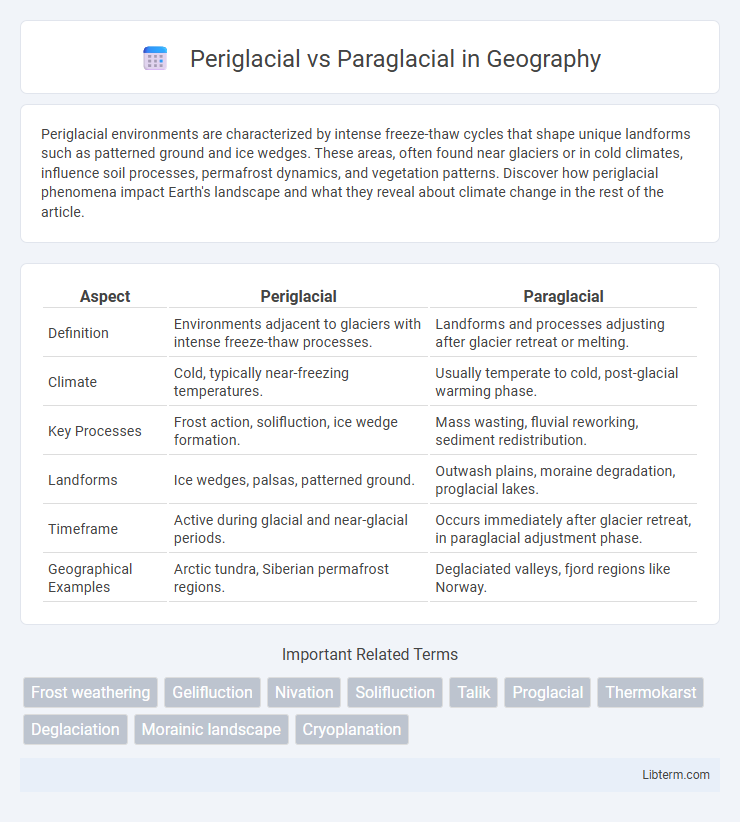Periglacial environments are characterized by intense freeze-thaw cycles that shape unique landforms such as patterned ground and ice wedges. These areas, often found near glaciers or in cold climates, influence soil processes, permafrost dynamics, and vegetation patterns. Discover how periglacial phenomena impact Earth's landscape and what they reveal about climate change in the rest of the article.
Table of Comparison
| Aspect | Periglacial | Paraglacial |
|---|---|---|
| Definition | Environments adjacent to glaciers with intense freeze-thaw processes. | Landforms and processes adjusting after glacier retreat or melting. |
| Climate | Cold, typically near-freezing temperatures. | Usually temperate to cold, post-glacial warming phase. |
| Key Processes | Frost action, solifluction, ice wedge formation. | Mass wasting, fluvial reworking, sediment redistribution. |
| Landforms | Ice wedges, palsas, patterned ground. | Outwash plains, moraine degradation, proglacial lakes. |
| Timeframe | Active during glacial and near-glacial periods. | Occurs immediately after glacier retreat, in paraglacial adjustment phase. |
| Geographical Examples | Arctic tundra, Siberian permafrost regions. | Deglaciated valleys, fjord regions like Norway. |
Understanding Periglacial and Paraglacial: Key Definitions
Periglacial environments are characterized by freeze-thaw processes affecting soil and rock near glacial regions, leading to features like patterned ground and solifluction lobes. Paraglacial zones develop following glacier retreat, where landscapes undergo rapid adjustment to the absence of ice, resulting in sediment redistribution and unstable slopes. Understanding the distinction highlights periglacial as cold-climate-driven landform generation, while paraglacial pertains to geomorphic responses triggered by deglaciation.
Geological Processes in Periglacial Environments
Periglacial environments are dominated by freeze-thaw cycles that drive processes such as frost heave, solifluction, and cryoturbation, reshaping the landscape through soil and sediment displacement. These cold-climate geological processes contribute to the formation of distinctive landforms like patterned ground, ice wedges, and thermokarst features. In contrast, paraglacial environments reflect the immediate post-glacial adjustment period, characterized by sediment redistribution and landscape stabilization following glacier retreat.
Characteristics of Paraglacial Landscapes
Paraglacial landscapes are characterized by environments undergoing rapid adjustments following glacial retreat, featuring unstable slopes, extensive sediment deposits, and dynamic fluvial systems driven by increased sediment supply. These areas exhibit high geomorphic activity, with processes such as mass wasting, river reworking, and vegetation colonization shaping the post-glacial terrain. Contrastingly, periglacial landscapes are defined by freeze-thaw cycles, permafrost presence, and features like patterned ground, which are not dominant in paraglacial zones.
Climate Influences on Periglacial Versus Paraglacial Zones
Periglacial zones are primarily influenced by cold climates with frequent freeze-thaw cycles that shape the landscape through soil freezing, frost heaving, and solifluction, whereas paraglacial zones develop in recently deglaciated environments where climatic warming drives rapid sediment redistribution by fluvial and mass-wasting processes. Temperature fluctuations dominate periglacial geomorphology by controlling permafrost dynamics and ground ice formation, while paraglacial environments respond more to climatic shifts that alter hydrology and sediment supply following glacier retreat. Understanding these distinct climate influences is essential for predicting landscape evolution in cold-region environments undergoing climate change.
Landforms Shaped by Periglacial Activity
Periglacial landforms are primarily shaped by freeze-thaw processes, frost heaving, and solifluction, resulting in features such as patterned ground, ice wedges, and pingos commonly found in cold, non-glacial environments. These landforms contrast with paraglacial features that develop in areas recently deglaciated, where sediment rearrangement and slope instability dominate, forming features like outwash plains and moraines. Periglacial activity significantly influences soil structure and surface morphology in permafrost regions, highlighting its role in shaping cold climate landscapes.
Paraglacial Sediment Dynamics and Erosion
Paraglacial sediment dynamics involve the reworking and rapid redistribution of previously glacially deposited materials due to increased meltwater flow and slope instability following glacier retreat. Erosion processes during the paraglacial phase are intensified by the lack of vegetation and unstable sediment, leading to heightened sediment mobilization and altered landscape morphology. These dynamics contrast with periglacial conditions, where freeze-thaw cycles and ice wedge activity dominate sediment movement and erosion.
Temporal and Spatial Scales of Periglacial and Paraglacial Processes
Periglacial processes dominate cold-climate landscapes over extensive timescales, often spanning thousands of years, and primarily occur in permafrost and tundra regions with persistent freezing temperatures. Paraglacial processes operate on shorter, more variable timescales, typically decades to centuries, triggered by rapid glacier retreat and resulting in landscape adjustments such as increased sediment flux and slope instability. Spatially, periglacial effects are widespread and stable across polar and high-altitude zones, while paraglacial dynamics are localized near glacier margins and proglacial environments, reflecting transitional stages following deglaciation.
Ecological Impacts in Periglacial and Paraglacial Regions
Periglacial regions, characterized by freeze-thaw cycles and permafrost, influence vegetation patterns and soil microbial communities, often leading to slow nutrient cycling and limited plant diversity. Paraglacial environments, shaped by glacier retreat and sediment redistribution, promote dynamic habitat formation and increased biodiversity through rapid colonization by pioneer species. Ecological impacts in periglacial zones mainly involve stress tolerance and adaptation to cold conditions, while paraglacial zones experience enhanced ecological succession and habitat heterogeneity.
Human Interactions with Periglacial and Paraglacial Landscapes
Human interactions with periglacial landscapes often involve adapting infrastructure to withstand freeze-thaw cycles, such as building insulated roads and foundations to prevent ground heave caused by permafrost thaw. In paraglacial environments, communities manage risks related to unstable slopes and sediment deposition resulting from recent glacier retreat, impacting land use and hazard mitigation strategies. Both landscapes require specialized knowledge in environmental management to address challenges in agriculture, construction, and resource extraction under dynamic climatic conditions.
Comparative Analysis: Periglacial vs Paraglacial Evolution
Periglacial environments evolve primarily through freeze-thaw cycles and processes like frost heave, which shape landscapes via cryogenic weathering and solifluction. Paraglacial landscapes, in contrast, develop from the destabilization and sediment redistribution following glacier retreat, marked by mass wasting and fluvial reworking. While periglacial evolution is driven by cold-climate mechanical weathering, paraglacial evolution is characterized by geomorphological adjustments to deglaciation and related sediment fluxes.
Periglacial Infographic

 libterm.com
libterm.com